Many dog owners debate whether or not dogs need shoes for hiking. The answer is that it depends on a variety of factors. Different boots can be used for various reasons, such as protecting the dog’s paws from hot or cold pavement, preventing drying out while walking on salted roads, and providing traction on icy snow. Some dogs have more sensitive paws and may require extra protection on rough terrain. I recommend that you consider the risks and benefits of using boots for hiking and to regularly check the dog’s paws for signs of wear or injury.
Key Takeaways:
- Dogs may need shoes for hiking to protect their paws from hot or cold pavement, rough terrain, and provide traction on slippery surfaces.
- Boots should fit properly and be made from comfortable, durable, and lightweight materials.
- Regularly check the dog’s paws for signs of discomfort or injury when using boots for hiking.
- Shoes may be unnecessary for dogs in mild weather or if they have trouble adapting to them.
- Consider other essential gear for dog hiking, such as water bottles, collapsible bowls, sit pads, and first-aid supplies.
Reasons to Use Boots for Hiking
When it comes to hiking with your dog, using boots can provide numerous benefits. Not only do they protect your furry friend’s paws from hot pavement, cold weather, and rough terrain, but they also offer additional traction on slippery surfaces. Dogs with more sensitive paws may especially benefit from the extra protection boots provide on challenging trails.
By choosing the right hiking boots for your dog, you can ensure their comfort and safety throughout your adventure. I highly suggest that you select boots that fit properly and regularly check your dog’s paws for any signs of discomfort or injury. This way, you can prevent chafing, rubbing, or any potential damage that ill-fitting boots may cause. To put it simply, finding the right boots for your dog is key to making their hiking experience enjoyable and worry-free.
Whether you’re exploring rocky trails, navigating icy terrain, or trekking through hot desert sands, investing in quality hiking boots for your dog is a smart decision. Not only do they provide paw protection and enhance traction, but they also give you peace of mind knowing that your canine companion is safe and comfortable during your outdoor adventures.
while boots offer many advantages, they also come with risks and considerations. In the next section, we’ll explore the potential downsides of using boots for hiking and what precautions you should take to ensure your dog’s well-being.
H3: Benefits of Using Boots for Hiking
There are several reasons why dog owners choose to use boots for hiking:
- Protection from hot pavement, cold weather, and rough terrain.
- Enhanced traction on slippery surfaces, such as snow or wet rocks.
- Prevention of cuts, scrapes, and injuries caused by sharp objects.
- Extra support and stability for dogs with sensitive paws.
By providing these benefits, boots can greatly improve your dog’s hiking experience and reduce the risk of paw-related issues. However, I would advise that you choose boots that fit properly and monitor your dog’s paws for any signs of discomfort or injury. In the next section, we’ll discuss the potential risks and considerations of using boots for hiking.
Table: Comparison of Popular Dog Hiking Shoes
| Brand | Features | Price |
|---|---|---|
| Brand A | Durable, breathable, water-resistant | $ |
| Brand B | Anti-slip sole, adjustable straps | $$ |
| Brand C | Reflective, insulated for cold weather | $$$ |
Note: Prices may vary depending on the retailer and availability. I recommend that you consider your dog’s specific needs and the features offered by each brand before making a purchase.

Risks and Considerations of Using Boots for Hiking
While boots can provide many benefits for dogs while hiking, consider the risks and considerations associated with using them. I recommend that you choose boots that fit properly to avoid discomfort and rubbing on certain areas of the dog’s paws, such as the dewclaws or carpal pads. Ill-fitting boots can also interfere with the dog’s natural gait and weight distribution, which can be harmful to their joints and spine in the long run.
Additionally, most boots are not breathable and can cause the paws to become moist, leading to chafing. The lack of breathability can also result in the growth of bacteria or fungi, increasing the risk of infections. I recommend that you take regular breaks and remove the boots to check the dog’s paws for any signs of irritation or injury.
While some dogs may benefit from using boots to protect their paws on rough or hot terrain, please monitor their comfort level and overall well-being during the hike. Each dog is unique, and what works for one may not work for another. Understanding the risks and considerations associated with using boots for hiking can help pet owners make informed decisions and ensure the safety and comfort of their furry companions.
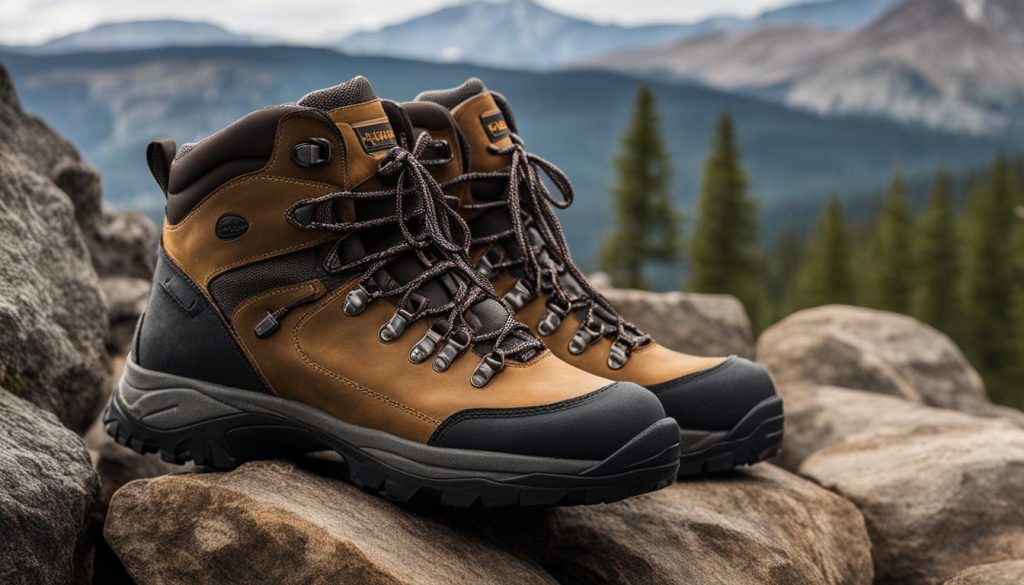
Tips for Choosing the Right Dog Boots
When it comes to choosing the right dog boots for hiking, there are a few factors to consider. The first step is to measure your dog’s paws to ensure you get the right size. This will help prevent discomfort and potential injuries caused by ill-fitting boots. Additionally, you’ll want to take into consideration the type of terrain your dog will be hiking on. If you’ll be encountering rough or rocky terrain, look for boots with durable soles that can provide protection and traction.
Comfort is key when selecting dog boots. Look for boots made from lightweight and breathable materials to ensure your dog’s comfort during long hikes. Adjustable boots are also important to ensure a secure fit. This will prevent the boots from sliding around or coming off during your hike. Water-resistance is another feature to consider, especially if you’ll be hiking in wet or muddy conditions.
Lastly, it’s a good idea to choose boots with non-slip soles. This will provide better traction and stability for your dog, especially on slippery surfaces. By taking these factors into consideration, you can choose the right dog boots that will keep your furry friend comfortable and protected throughout your hiking adventures.
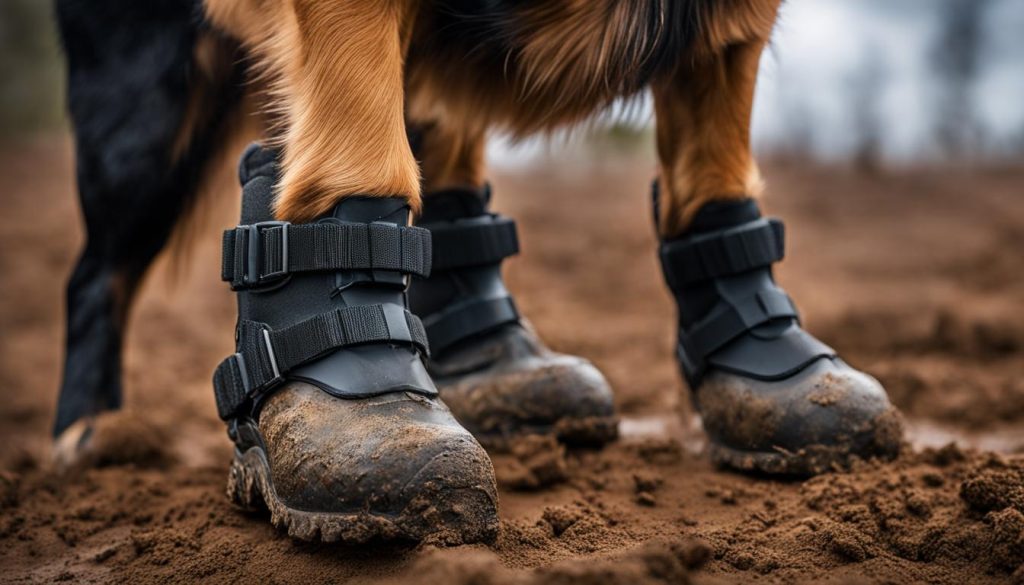
When Are Dog Shoes Unnecessary?
While dog shoes can provide numerous benefits for hiking, there are certain situations where they may be unnecessary. One such instance is when you live in an area with mild weather and your dog doesn’t spend much time outdoors. In these cases, the natural toughness of your dog’s paws may be sufficient protection.
Some dogs may also have trouble adapting to wearing shoes and may try to remove them or chew on them, making them impractical. If your dog consistently shows discomfort or resistance to wearing shoes, it may be best to forego them and explore alternative ways to protect their paws.
I recommend that you consider the fit and comfort of the shoes as well. If the shoes are uncomfortable or ill-fitting, they can cause more harm than good. Regularly check your dog’s paws for any signs of discomfort or irritation caused by the shoes, and consult with a veterinarian if you have any concerns.
Ultimately, the decision to use dog shoes for hiking should be based on the individual needs and comfort of your dog. Assess the terrain, weather conditions, and sensitivity of your dog’s paws to determine if shoes are necessary for a safe and enjoyable hiking experience.
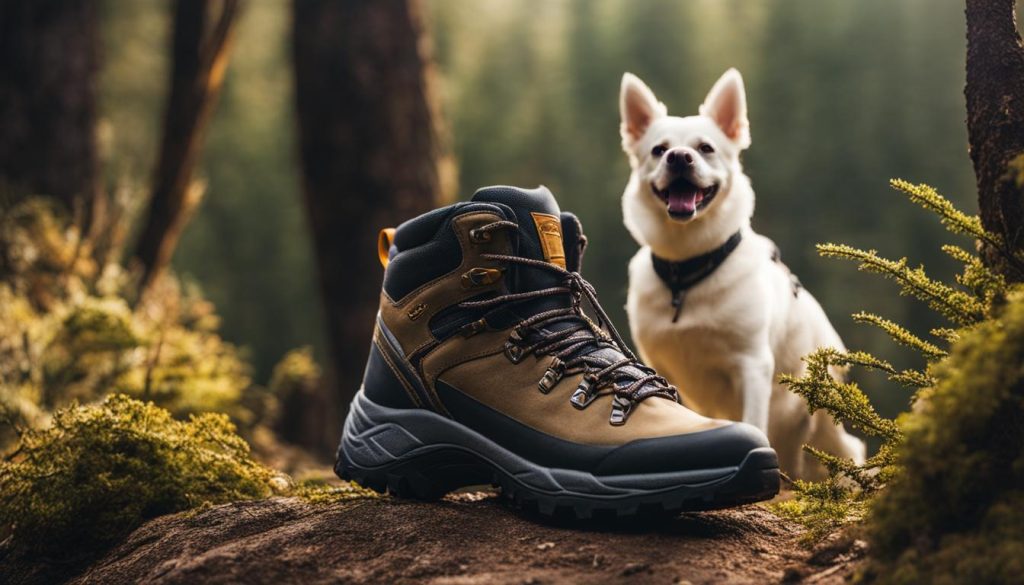
When Are Dog Shoes Unnecessary?
| Situation | Considerations |
|---|---|
| Mild weather and limited outdoor time | The natural toughness of the dog’s paws may be sufficient protection. |
| Dog resistance to wearing shoes | Some dogs may have difficulty adapting to shoes and may try to remove or chew on them. |
| Uncomfortable or ill-fitting shoes | The wrong fit or uncomfortable shoes can cause discomfort or harm to the dog’s paws. |
Other Gear for Dog Hiking
When it comes to dog hiking, having the right gear is essential for a safe and enjoyable experience. In addition to hiking boots or shoes, there are other items that should be included in your dog hiking gear. These essentials will ensure that your furry friend is comfortable, hydrated, and prepared for any unexpected situations that may arise on the trail.
Water Bottle and Collapsible Bowl
Staying hydrated is crucial for both you and your dog during a hike. Bring a water bottle specifically designed for dogs, such as one with a flip-up bowl attachment. This makes it easy to provide your dog with water without having to carry a separate bowl. Look for a bottle that is lightweight and leak-proof, so you can easily carry it in your backpack.
Sit Pad or Blanket
Dogs need a comfortable place to rest and recuperate during breaks on the trail. Bring a sit pad or blanket that your dog can relax on when taking a break. Look for one that is lightweight and easy to carry, such as a foldable or compact design. This will provide a clean and comfortable spot for your dog to rest, regardless of the terrain.
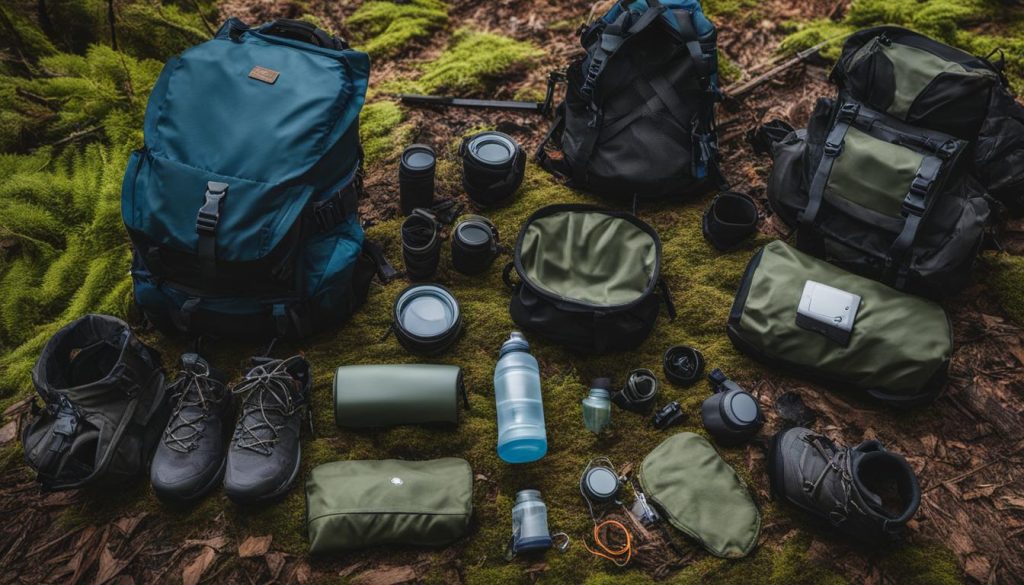
Fine-Tooth Comb and Tweezers
While hiking, your dog may encounter burrs, cactus spines, or other debris that can become lodged in their fur. I recommend that you have a fine-tooth comb and tweezers on hand to remove any irritants. A fine-tooth comb will help detangle any knots or mats that may form during the hike, while tweezers can be used to carefully remove burrs or spines. This will prevent discomfort and potential injury to your dog.
First-Aid Kit
Accidents can happen on the trail, so be prepared with a first-aid kit specifically designed for dogs. Include essential items such as bandages, antiseptic wipes, and tweezers. This will allow you to quickly and effectively treat any minor injuries or cuts that your dog may sustain while hiking. Having a first-aid kit will give you peace of mind and ensure that you can properly care for your dog in case of an emergency.
By packing these essential items in your dog hiking gear, you can ensure that your furry friend is well-prepared for any adventure on the trail. Try to choose gear that is lightweight, durable, and suitable for your dog’s specific needs. With the right gear, you and your dog can enjoy many memorable hikes together.
The Benefits of Shoes for Dogs in the Desert
When it comes to hiking in the desert with your furry friend, dog shoes can provide numerous benefits to ensure their safety and comfort. The desert terrain can be harsh, with hot sand and rocky surfaces that can cause burns or injuries to your dog’s sensitive paws. By using dog hiking shoes specifically designed for desert conditions, you can protect their paws from the scorching heat and provide better traction on slippery surfaces.
One of the key benefits of dog shoes in the desert is protecting your pet from the extreme temperatures. The hot sand can quickly heat up and burn their paws, causing pain and discomfort. Insulated shoes or booties can provide an additional layer of protection, keeping their paws cool and preventing burns. Furthermore, these shoes can also shield their paws from sharp rocks and cacti thorns, reducing the risk of injury during the hike.
Choosing lightweight and breathable dog shoes is crucial to ensure your pet’s comfort in the desert. The shoes should allow proper airflow to prevent their paws from becoming sweaty and moist, which can lead to chafing and discomfort. Additionally, non-slip soles on the shoes can help your dog maintain stability and grip on sandy or uneven terrain, preventing slips and falls.

In summary, using dog shoes in the desert during hikes can provide essential protection for your furry companion. The right shoes can shield their paws from hot sand, sharp rocks, and cactus thorns, reducing the risk of burns and injuries. Opt for lightweight, breathable shoes with non-slip soles to ensure your pet’s comfort and stability. Try to choose the shoes that fit properly and regularly check your dog’s paws for any signs of discomfort or wear. With the right gear, you and your dog can enjoy a safe and enjoyable hiking experience in the desert.
Precautions for Desert Hiking with Dogs
When embarking on a desert hiking adventure with your dog, take extra precautions to ensure their safety and well-being. The desert can present unique challenges, including scorching temperatures, rough terrains, and potential hazards like cactus spines and rattlesnakes. By following a few essential precautions, you can ensure a successful and enjoyable hike for both you and your furry companion.
Sufficient Water Supply
The desert can be an unforgiving environment, especially during the summer months when temperatures can reach extreme highs. I highly suggest that you carry an ample supply of water for both yourself and your dog. Dogs can quickly become dehydrated, so offer them water regularly during breaks. Consider investing in a collapsible water bowl for convenience.
Protective Dog Boots
The hot sand and rocky terrain of the desert can be harsh on your dog’s paws. Investing in a good pair of dog hiking shoes can provide much-needed protection against burns, cuts, and irritations. Look for boots that are specifically designed for hiking in hot climates and ensure they fit comfortably on your dog’s paws.
Comfortable Resting Area
The desert ground can be rough and uncomfortable for your dog to rest on. Bringing along a sit pad or blanket will provide them with a comfortable spot to relax during breaks. It will also help to prevent them from coming into contact with hot sand or sharp objects.

Vigilance and Observation
While hiking in the desert, I would advise that you be vigilant and observe your dog’s behavior closely. Watch for signs of fatigue, discomfort, or overheating. If your dog shows any signs of distress, be prepared to take immediate action by finding shade, offering water, or seeking veterinary assistance if necessary.
By taking these precautions, you can ensure a safe and enjoyable desert hiking experience with your canine companion. Try to plan your route carefully, be mindful of local regulations, and always prioritize your dog’s well-being. With the right preparation and precautions, you and your dog can create lasting memories together in the beautiful desert landscape.
Additional Tips for Desert Hiking with Dogs
When preparing for desert hiking with dogs, keep a few additional tips in mind to ensure a safe and enjoyable experience for both you and your furry companion. Here are some key considerations:
1. Rattlesnake Awareness and Training:
Being aware of the presence of rattlesnakes in the desert is crucial for your dog’s safety. Consider enrolling your dog in a rattlesnake aversion training program to teach them how to avoid these dangerous reptiles. This training can help prevent potential snake bites and keep your dog safe during your hike.
2. Carry a First-Aid Kit:
A well-stocked first-aid kit is essential when hiking with dogs, especially in the desert where medical help may be far away. Make sure your kit includes essential supplies such as bandages, antiseptic, and tweezers to handle any minor injuries or emergencies that may arise.
3. Monitor Your Dog’s Behavior:
Pay close attention to your dog’s behavior during the hike. Watch for signs of discomfort, fatigue, or dehydration. Dogs can’t communicate their needs, so be vigilant and provide them with enough rest and water breaks along the way. If you notice any concerning behavior or symptoms, consider ending the hike and seeking veterinary care if necessary.
By following these additional tips, you can ensure a safe and enjoyable desert hiking experience with your dog. Try to always prioritize your dog’s well-being and make decisions that are in their best interest. Happy hiking!
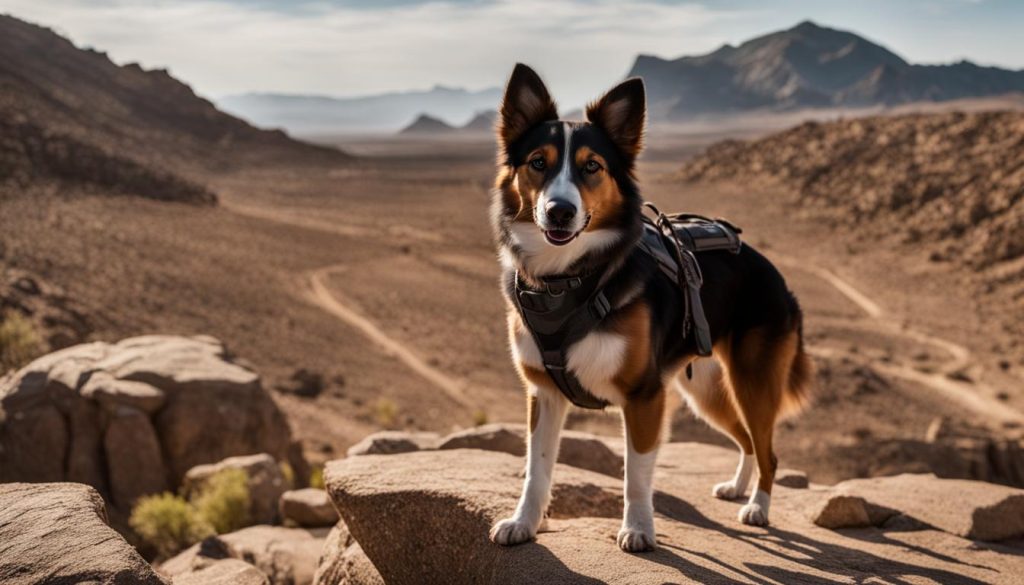
Final Thoughts
After exploring the various factors surrounding the use of shoes for dogs while hiking, it is clear that the decision depends on the individual dog’s needs and the specific hiking conditions. While boots can provide protection and traction, they also come with risks and considerations that must be taken into account.
When considering whether or not to use shoes for hiking, you should assess the terrain, temperature, and sensitivity of the dog’s paws. Boots can be beneficial for protecting against hot pavement, cold weather, and rough terrain. They can also provide better traction on slippery surfaces and prevent cuts or scrapes. However, ill-fitting boots or those made from non-breathable materials can cause discomfort and pose a risk to the dog’s joints and spine.
Choosing the right dog boots for hiking is crucial. Proper fit, comfortable materials, and water-resistance are important factors to consider. Regularly checking the dog’s paws for signs of wear or injury is essential to prevent any harm. Ultimately, the decision to use shoes for hiking should prioritize the individual needs and comfort of the dog.
FAQ
Do dogs need shoes for hiking?
The answer depends on various factors such as the terrain, temperature, and sensitivity of the dog’s paws.
What are the reasons to use boots for hiking?
Boots can protect the dog’s paws from hot pavement, cold weather, rough terrain, provide traction, and prevent cuts or scrapes.
What are the risks and considerations of using boots for hiking?
Some boots may cause discomfort or rubbing, ill-fitting boots can affect the dog’s gait and weight distribution, and boots can cause the paws to become moist and chafed.
What are the tips for choosing the right dog boots?
Measure your dog’s paws, consider the terrain, choose comfortable and lightweight materials, ensure a secure fit, and look for water-resistant and non-slip soles.
When are dog shoes unnecessary?
If you live in mild weather and your dog doesn’t spend much time outdoors, or if the shoes are uncomfortable or ill-fitting.
What other gear is necessary for dog hiking?
Water bottle and bowl for hydration, sit pad or blanket for resting, fine-tooth comb for removing debris from fur, tweezers and first-aid tape for emergencies.
What are the benefits of shoes for dogs in the desert?
Shoes can protect against hot sand and rocky terrain, prevent burns on the paws, provide traction, and keep the paws warm in cold temperatures.
What precautions are necessary for desert hiking with dogs?
Carry plenty of water, use dog boots for paw protection, provide a sit pad or blanket for resting, and carry a fine-tooth comb and tweezers for removing debris.
What are additional tips for desert hiking with dogs?
Be aware of rattlesnakes and consider aversion training, carry a first-aid kit, and monitor your dog’s behavior and signs of discomfort or fatigue.






